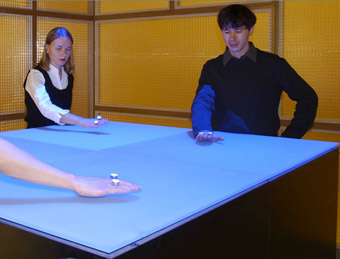As a Bruin, I am quite sorry to say this, but I visited the USC Fischer Exhibit, instead of our own exhibits at the Hammer or Fowler Museum. However, the place itself was quite nice but small; they were holding typing classes in the other rooms, so it was actually sort of noisy. And so, here we are at the entrance of the exhibit with the worker:
 |
| The worker and us |
As one of five exhibitions that capture the interaction between visual art and language, Alexandra Grant's exhibit Drawn to Language, while beautiful and stunning, really allowed my mind to explore what exactly it was she was trying to say through her art. For art like these, I virtually at first had no idea how to interpret them:
I eventually realized, though, that her art explores the subject of psychology, the unconscious, and the construction of the Self. By utilizing all the different colors and textual quotations shown above, she manages to create these vibrant works of art, which serves to explore how we define who we are, or what the voices populate our unconscious while shaping us. According to the information of the display, many of her sources come from Sophocles' Anigone, texts by Freud and his followers, and also other books that probe the unconscious mind, from surrealism to feminism.

I felt that this exhibit really pertains to what we have studied during this course. In Unit 7, we learned about neuroscience and art, and how for example, artists have explored many ways to try to depict the brain in works of art. For instance, we learned about the Amygdaloid's music video, in which they explore our brain's ability to react in unusual ways when we see. Here, Alexandra Grant is clearly trying not only to show how our brain works through art, but in fact, trying to delve deeper and explore the unconscious. I feel this artwork has such a deep meaning that even now, I have trouble exploring and interpreting exactly what she is trying to tell the viewers.
I would definitely recommend visiting this exhibit, if it is still being displayed. The museum staff are all really nice, and it really is a nice area to be around. However, if you don't feel like venturing onto Trojan territory, you can always just visit the Hammer and the Fowler Museum!




























